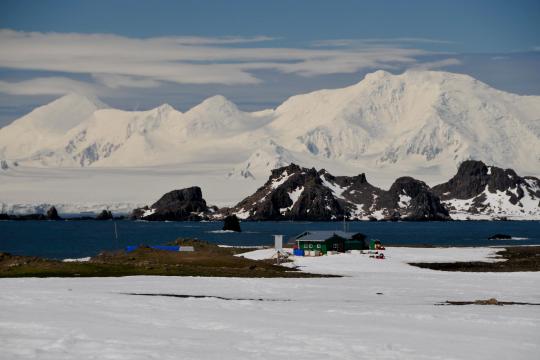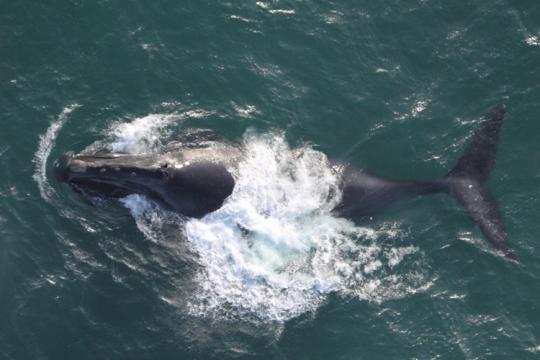 Cape Shirreff field camp on Livingston Island, one of the most breathtaking places in Antarctica. Credit: NOAA Fisheries
Cape Shirreff field camp on Livingston Island, one of the most breathtaking places in Antarctica. Credit: NOAA Fisheries
 North Pacific right whale. Credit: Brenda K. Rone
North Pacific right whale. Credit: Brenda K. Rone
Studying life history and health using marine mammal carcasses
Stranding networks and fishery observer programs provide researchers valuable data which are otherwise unobtainable. These programs have provided much of the data we have about cetacean species living off California and in the eastern tropical Pacific. By examining marine mammal carcasses, we can learn about a species' life history, occurrence, population structure, disease prevalence, and anthropogenic causes of mortality. Tissue samples and skeletal material collected from these animals are archived at SWFSC and museums, respectively. The archive of samples and associated data about individual animals have facilitated technique development, incorporation of photogrammetric data into life history studies and retrospective studies.
Learn about cetacean stranding investigations here.
Data collected from carcasses are critical to learning about marine mammal life history.
Visit this site to see what we collect and how tissues are used.
Fishery observer programs provide a unique opportunity to collect data about a species from the habitat in which they live. Fishery observers are trained to collect biological samples from incidentally killed marine mammals. The suite of data collected includes species identification, gender, and total body length, as well as samples of skin for genetics, gonads for reproductive status determination, stomachs for documenting prey, teeth for age, and the skeleton for morphological studies.
The NMFS West Coast Region monitors fishery bycatch through their observer program. SWFSC processes biological samples collected from marine mammals, cetaceans and pinnipeds, from the gillnet fisheries that operate off the California coast. Observers are placed on about 20% of all fishing trips and are instructed to sample marine mammals that are accidentally killed in gillnets. Recently imposed time/area closures to protect turtle species have resulted in reduced incidental marine mammal takes. Short-beaked common dolphin are the most frequently taken species in the fishery, but since the observer program started in 1990, most of the cetacean species living off the coast have been entangled in gillnets including sperm whales, fin whales and several beaked whale species. Here we show how fishery observer data and collections provide additional life history data.
To report a dead marine mammal in San Diego County, call 858-546-7162
To report a live marine mammal in San Diego County, call 800-541-7325
To report a stranded marine mammal in another region of the United States, click here.
[KD1]Leave current photo as is
 Cape Shirreff field camp on Livingston Island, one of the most breathtaking places in Antarctica. Credit: NOAA Fisheries
Cape Shirreff field camp on Livingston Island, one of the most breathtaking places in Antarctica. Credit: NOAA Fisheries
 North Pacific right whale. Credit: Brenda K. Rone
North Pacific right whale. Credit: Brenda K. Rone
